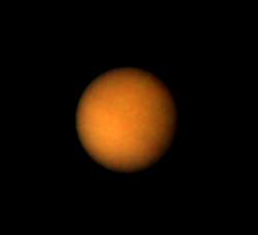Geotimes

Web
Extra Friday,
October 10, 2003
Hydrocarbon oceans on Titan
 Ground-based radar
telescopes finally have penetrated the hazy atmosphere of Saturn's largest moon
to yield the first reliable evidence that it might have hydrocarbon oceans.
Researchers report their data from Titan matches the expected signal of mixed
liquid hydrocarbons, including methane and ethane, online in the Oct. 2 SciencExpress.
Ground-based radar
telescopes finally have penetrated the hazy atmosphere of Saturn's largest moon
to yield the first reliable evidence that it might have hydrocarbon oceans.
Researchers report their data from Titan matches the expected signal of mixed
liquid hydrocarbons, including methane and ethane, online in the Oct. 2 SciencExpress.
Carl Sagan and Stan Dermott had proposed a pure methane ocean on Titan in 1982,
but Voyager's first pass by the moon observed temperatures and other
conditions that did not fit their model. The following year, researchers determined
a mixed hydrocarbon ocean would better fit the Voyager data. But the
capability to measure Titan's surface with more certainty has come only within
the past decade.
Titan's clouds may be hiding a methane-ethane
ocean beneath, with the most solid confirmation yet from recent ground-based
radar observations. Image courtesy of NASA Jet Propulsion Lab.
From the Arecibo Observatory in Puerto Rico, the researchers shot a radar beam
at 13-centimeter wavelengths to Titan and waited to receive the reflection (which
took about two hours). With ground-based radar observations, "Titan is
about as far away as we can look," says Don Campbell of Cornell University,
in Ithaca, N.Y., lead author of the research. The team made a second set of
observations during the same time period in the following year, at the Green
Bank Observatory in West Virginia, to back up the data.
The team acquired several measurements that painted a fuzzy picture of the sunlit
half of Titan's surface, with a relatively clearer core of reflection from the
center, called the specular component. Just as the sun's rays glint off the
faces of water waves, some of the radar reflects back directly to the viewer
from that specular center point.
The reflection patterns at the 13-centimeter radar wavelength show a smooth
surface at that scale. The data also seem to match what are known to be the
reflection patterns of a mix of liquid hydrocarbons at that wavelength. Titan's
surface is about -179 degrees Celsius (-291 F). At those temperatures, Campbell
says, a mix of ethane, methane and nitrogen could mingle in liquid form.
Ethane is probably one of the major products of photochemical reactions in Titan's
upper atmosphere, and it could rain out onto the surface. Campbell also says
that such hydrocarbon oceans would serve to replenish Titan's methane-rich atmosphere,
which is proportionally 10 times larger than Earth's. Otherwise, the methane
would be stripped away in about 10 million years through interactions with ultraviolet
light.
Campbell and his co-workers note that the reflection patterns also could match
a mix of smooth ice — either water, ammonia-rich water or some other organic-rich
ice. However, they say it is highly unlikely because of known measurements in
those wavelengths. They also note that the data show up to 75 percent of Titan's
surface could be covered with hydrocarbon lakes or oceans, which is also unlikely,
Campbell says. Instead, the surface might have varying surface roughness (with
regard to reflectance) and therefore mixed substances.
Jonathan Lunine, at the Lunar and Planetary Laboratory at the University of
Arizona in Tucson, calls the paper "a very careful piece of work."
Lunine and his coworkers were the first to suggest a mixed hydrocarbon ocean.
As for substances other than liquid hydrocarbons, Lunine notes that water mixed
with ammonia covering the surface would have to remain as smooth as an ice-skating
rink, despite erosion, impacts or other surface processes. Liquid hydrocarbons,
however, would always stay smooth. "If I had to choose between the two
options," he says, "it's much easier for me to believe that 70 percent
is covered in hydrocarbons than to believe so much of the surface was resurfaced
with ammonia water flows, so recently that it's still smooth."
"We have been wanting to test this hypothesis for two decades," says
Caitlin Griffith, a Titan specialist also at the Lunar and Planetary Laboratory.
"There have been repeated measurements of the kind Campbell et al. performed,
but with not as good fidelity," she says.
Now scientists must wait for further confirmation of the new ground-based observations
from the upcoming Cassini mission. The NASA mission should reach Titan
by July 2004. It will make close passes to the moon, and using near-infrared
observations and a surface probe, it will pierce the satellite's atmosphere
to see the surface below.
Naomi Lubick
Links:
Images from the Jet
Propulsion Lab
The
Cassini mission
"Oceans
beyond Earth," Geotimes, January 2002
Back to top
 Ground-based radar
telescopes finally have penetrated the hazy atmosphere of Saturn's largest moon
to yield the first reliable evidence that it might have hydrocarbon oceans.
Researchers report their data from Titan matches the expected signal of mixed
liquid hydrocarbons, including methane and ethane, online in the Oct. 2 SciencExpress.
Ground-based radar
telescopes finally have penetrated the hazy atmosphere of Saturn's largest moon
to yield the first reliable evidence that it might have hydrocarbon oceans.
Researchers report their data from Titan matches the expected signal of mixed
liquid hydrocarbons, including methane and ethane, online in the Oct. 2 SciencExpress.
